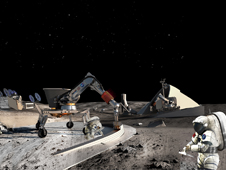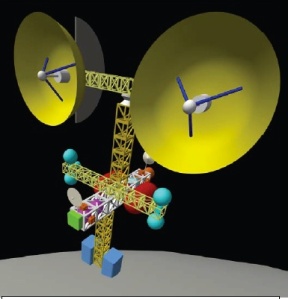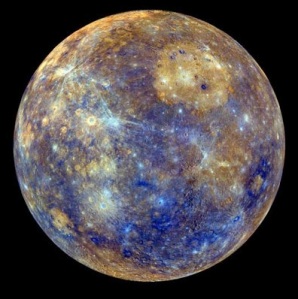= NASA's NIAC: New and Innovative Advance Concepts =
Soon I will be off to participate as an advisor in the Spring Symposium of NASA-NIAC in Chicago. NIAC is a far-out, little research program at NASA, trying to enable big things in space. NIAC stands for NASA Innovative Advanced Concepts. Its budget last year was only $5.5M, or about 3/100ths of 1% of the $18 billion NASA budget. Its charter is to Change the Possible in aerospace. NIAC studies exciting, unexplored missions that won't be "ready for prime time" for a decade or more. Here are a few of the phenomenal projects they funded last year, chosen at random:
 • A researcher at USC is trying to "3-d print" whole buildings with quick drying concrete. Behrokh Khoshnevis is working with NIAC to see if it's possible to do this on the Moon or on Mars, using local soil, to build basic infrastructure in preparation for a future NASA mission.
• A researcher at USC is trying to "3-d print" whole buildings with quick drying concrete. Behrokh Khoshnevis is working with NIAC to see if it's possible to do this on the Moon or on Mars, using local soil, to build basic infrastructure in preparation for a future NASA mission.
• NIAC has a researcher at Draper Labs, Kevin Duda, who is working on a space suit that would help astronauts feel a sense of "down" while in space for a long time. It might also help them exercise just by doing their regular movements. The suit has gyros on it that resist motion intelligently for that sense of "down".
• Kendra Short at JPL is trying to print small spacecraft. Not 3-D printing, but rather flexible printed electronics, batteries, sensors, everything on a sheet of mylar or even paper. This could be used anywhere in the solar system to rapidly design and print useful electronics.
 • An interesting robotic rover is being designed with Mars in mind. Adrian Agogino is adapting tensegrity structures to make an inexpensive and durable rover, the Super Ball Bot, that you could simply drop down to Mars — no a parachute or airbags needed.
• An interesting robotic rover is being designed with Mars in mind. Adrian Agogino is adapting tensegrity structures to make an inexpensive and durable rover, the Super Ball Bot, that you could simply drop down to Mars — no a parachute or airbags needed.
• Here's an example of a project NIAC is funding on next-generation life support systems: Michael Flynn is developing Water Walls, Redundant Life Support Architecture, a concept to put the waste water processing into the walls of a spacecraft so that the water and waste would protect against radiation, too.
 • NIAC is funding a small asteroid mining study. With the Robotic Asteroid Explorer, Mark M. Cohen is trying to figure out if mining an asteroid could ever make real business sense. If so, what might be valuable to mine in space, and how could it be accomplished?
• NIAC is funding a small asteroid mining study. With the Robotic Asteroid Explorer, Mark M. Cohen is trying to figure out if mining an asteroid could ever make real business sense. If so, what might be valuable to mine in space, and how could it be accomplished?
One of the coolest parts of NIAC is how open it is: info about all their studies is freely available at http://www.nasa.gov/niac. Also, they have their projects report out to the program office at public meetings, the NIAC Symposiums. The next is in Chicago from March 12-14th. See their website for details on the Spring Symposium.
== More Exciting space news ==
The next three years will feature truly astounding announcements regarding human spaceflight: half a dozen new commercial and potentially human-crewed space vehicles, including:
--XCOR Aerospace's Lynx suborbital space plane
--Virgin Galactic's SpaceShipTwo
--Armadillo Aerospace's Vertical Lander
--Stratolaunch's Air-Launched Rocket
--Blue Origin's Space Vehicle
--Sierra Nevada's Dream Chaser Space Plane
 A way cool concept that emerged from MIT, JPL and NASA NIAC... a Phobos mission (to replace the doomed Russian one) would start with an orbiter that then deploys several small "hedgehog" landers that fling themselves across the microgravity surface by sudden tilts driven by gyros and flywheels. I have long pushed for Phobos as a target. It could very well be one of the most valuable sites in the solar system.
A way cool concept that emerged from MIT, JPL and NASA NIAC... a Phobos mission (to replace the doomed Russian one) would start with an orbiter that then deploys several small "hedgehog" landers that fling themselves across the microgravity surface by sudden tilts driven by gyros and flywheels. I have long pushed for Phobos as a target. It could very well be one of the most valuable sites in the solar system.
An electric sail produces propulsion power for a spacecraft by utilizing the solar wind (charged particles) instead of light. The sail features electrically charged long and thin metal tethers that interact with the solar wind. See the latest plans.
EmDrive, China's radical new space drive using microwaves that seems to violate Newton's laws by requiring no propellant mass?Professor William Napier and Dr. Janaki Wickramasinghe have completed computer simulations of our sun’s movements in its outer spiral location in the Milky Way, and determined that we are now entering a danger zone where molecular clouds might perturb the solar system -- the odds of asteroid impact on Earth go up by a factor of ten.
Watch a great (and personal) tour of the International Space Station given by Sunny Williams just immediately prior to her departure from the ISS a month or so ago. She literally gave it the day of her return to Earth… after commanding the ISS for the prior 3 months.
Not to be missed! Google has created a visualization of the 100,000 stars nearest to the solar system, based on actual astronomical data. You can zoom in all the way to the solar system to see how small Neptune's orbit is relative to the Oort Cloud, or zoom right out to see how puny 100,000 stars is in just our quarter of the Milky Way galaxy.
 Scientists spin carbon nanotube threads on an industrial scale. This is huge - not just for a Space Elevator but for construction in general. There's a cool video showing how they do it - they're not keeping it all secret...
Scientists spin carbon nanotube threads on an industrial scale. This is huge - not just for a Space Elevator but for construction in general. There's a cool video showing how they do it - they're not keeping it all secret...
And finally, a gorgeous false-color image of Mercury. NASA's Messenger space probe has been mapping the surface, and has detected evidence of water ice and volatiles at the permanently shaded poles of Mercury.
== Finally: space rocks redux ==
All this ruckus led to my serving a stint as astronomy pundit on BBC. My job on-air was to reassure that there would be no radiation… that in fact, bolides like this one seem to strike our planet once a decade or so, but always till now over open ocean or deserts or countryside. (In the 1970s one such event, off Japan, almost triggered a rise in DEFCON alert level at the US NORAD!) This was the first ever to perturb a city.
Anyway, we still aren't "safe." Comets (my area of scientific expertise) could swoop down from almost any direction, almost any time. So let's become more capable of living and working out there in space! Our proper path is vigorously forward.




Comments